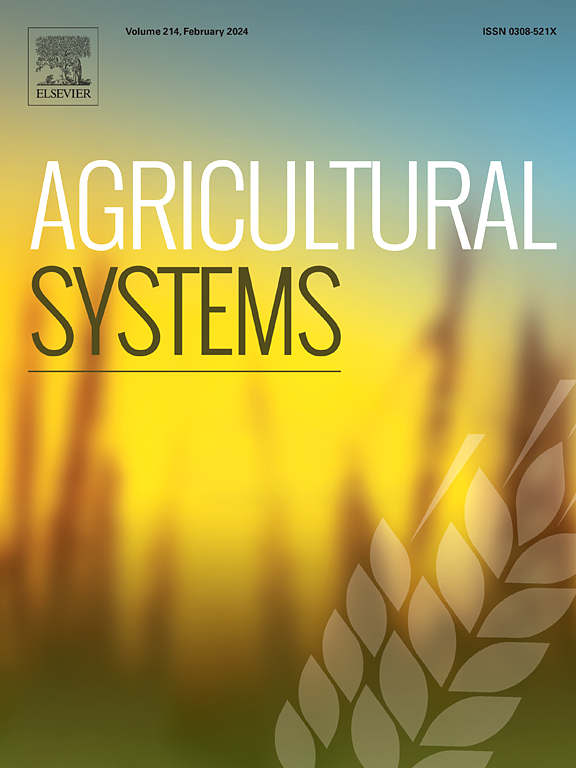Climatic constraints behind spatial and temporal variability of wheat yields in the Pampa region of Argentina
IF 6.1
1区 农林科学
Q1 AGRICULTURE, MULTIDISCIPLINARY
引用次数: 0
Abstract
Context
The Argentine wheat belt region is centered on the humid pampas, i.e. the main wheat producing area of Argentina and is considered at global scale one of the most important in the world for its production of cereals and oilseeds crops. In this whole area wheat is exposed to contrasting climatic conditions.
Objectives
The main objective was to study, at a regional scale, the spatial and temporal variability of wheat yields in Argentina and its relationship with climatic conditions. We seek to answer 3 questions: (a) How does climate affect the spatial distribution of wheat yields in the Pampas region? (b) What are the main agroclimatic variables that modulate the temporal variability of wheat yields in the Pampas region? and (c) Based on what is identified in “b”, is it possible to determine areas of homogeneous behavior?
Methods
A large agrometeorological data base was contrasted with the yield of wheat recorded in the main area of wheat production in Argentina from 1985 to 2021. The CRONOTRIGO (http://cronotrigo.agro.uba.ar/) model was used to establish the phenology of different wheat cultivars for a range of optimal sowing dates and associate phenological stages to the climatic variables.
Results and conclusions
In the studied area average yield ranged from 1200 to 3600 Kg ha−1, with the lowest and the highest yields in the north and southeast region, respectively. The combination of yield variability with agroclimatic variables allowed the identification of two mega-environments, mainly affected by the water deficits and by the VPD during the critical period, maximum temperatures, and heat shock events during grain-filling period at the west, and photothermal quotient during the critical period at the east. Mega-environment located at the east showed a lower climatic influence over yield variability than that located at the west of the wheat belt. This analysis allowed us to identify homogeneous regions in terms of agroclimatic variables affecting yield variability in wheat.
Significance
This information provides insight for understanding the spatio-temporal variation in wheat yield, which will help to reduce yield gaps by adjusting agronomic management according to the main environmental constraint.

背景阿根廷小麦带地区以湿润的潘帕斯草原为中心,是阿根廷的主要小麦产区,在全球范围内被认为是世界上最重要的谷物和油籽作物产区之一。在这整个地区,小麦面临着截然不同的气候条件。目标主要目的是在区域范围内研究阿根廷小麦产量的时空变化及其与气候条件的关系。我们试图回答 3 个问题:(a) 气候如何影响潘帕斯地区小麦产量的空间分布?(b) 影响潘帕斯地区小麦产量时间变异性的主要农业气候变量是什么? (c) 根据 "b "中确定的内容,是否有可能确定行为一致的地区?利用 CRONOTRIGO(http://cronotrigo.agro.uba.ar/)模型确定了不同小麦栽培品种在一系列最佳播种期的物候期,并将物候期与气候变量联系起来。结果与结论在研究区域内,平均产量在 1200 至 3600 公斤/公顷之间,北部和东南部地区的产量分别最低和最高。将产量变化与农业气候变量相结合,可以确定两个巨型环境,主要受缺水和临界期 VPD 的影响,西部地区受最高温度和谷物灌浆期热冲击事件的影响,东部地区受临界期光热商的影响。与小麦带西部相比,东部的巨型环境对产量变化的气候影响较小。这些信息为了解小麦产量的时空变化提供了洞察力,有助于根据主要环境限制因素调整农艺管理,从而缩小产量差距。
本文章由计算机程序翻译,如有差异,请以英文原文为准。
求助全文
约1分钟内获得全文
求助全文
来源期刊

Agricultural Systems
农林科学-农业综合
CiteScore
13.30
自引率
7.60%
发文量
174
审稿时长
30 days
期刊介绍:
Agricultural Systems is an international journal that deals with interactions - among the components of agricultural systems, among hierarchical levels of agricultural systems, between agricultural and other land use systems, and between agricultural systems and their natural, social and economic environments.
The scope includes the development and application of systems analysis methodologies in the following areas:
Systems approaches in the sustainable intensification of agriculture; pathways for sustainable intensification; crop-livestock integration; farm-level resource allocation; quantification of benefits and trade-offs at farm to landscape levels; integrative, participatory and dynamic modelling approaches for qualitative and quantitative assessments of agricultural systems and decision making;
The interactions between agricultural and non-agricultural landscapes; the multiple services of agricultural systems; food security and the environment;
Global change and adaptation science; transformational adaptations as driven by changes in climate, policy, values and attitudes influencing the design of farming systems;
Development and application of farming systems design tools and methods for impact, scenario and case study analysis; managing the complexities of dynamic agricultural systems; innovation systems and multi stakeholder arrangements that support or promote change and (or) inform policy decisions.
 求助内容:
求助内容: 应助结果提醒方式:
应助结果提醒方式:


